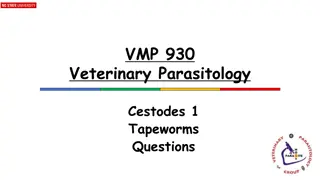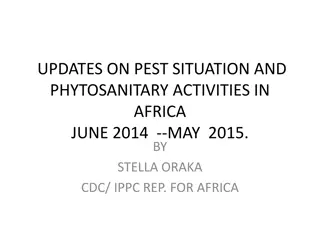Overview of Jaw Cysts: Classification and Clinical Features
A cyst in the jaw is a fluid-filled cavity lined by epithelium that commonly occurs in the jawbones. There are different types of jaw cysts, such as odontogenic cysts and non-odontogenic cysts, each with specific clinical features and radiographic appearances. Understanding the classification and fe
9 views • 13 slides
Understanding Nasmyth's Membrane and Dentigerous Cysts in Dental Health
Nasmyth's Membrane is a residue found on newly erupted teeth, causing extrinsic staining. It can be treated with selective polishing and proper brushing. Dentigerous cysts, odontogenic cysts associated with developing teeth, may lead to dental issues. Treatment for cysts includes monitoring and, if
0 views • 9 slides
Understanding Odontogenic Cysts in Maxillofacial Region
Odontogenic cysts may occur centrally within bones of the maxilla and mandible, predominantly in tooth-bearing areas. Types include radicular cysts, residual cysts, and dentigerous cysts, each with distinct radiographic features and epicenter locations. Radicular cysts are commonly found around nonv
0 views • 7 slides
Understanding Echinococcus Granulosus and Hydatid Disease
Echinococcus Granulosus, also known as the hydatid worm or dog tapeworm, causes cystic echinococcosis. The tapeworm has distinct characteristics and a complex life cycle involving canids as definitive hosts and humans as accidental hosts. Hydatid disease in humans can be dangerous, with symptoms var
0 views • 8 slides
Complex Radiology Case: Multiple Traumatic Injuries in an Elderly Female
A 77-year-old female presented with multiple traumatic injuries after falling headfirst down stairs. Imaging revealed a comminuted inferior orbital wall fracture, facial lacerations, spinal fractures, and cervical cord syndrome. Lab findings indicated preexisting conditions like osteopenia, hyperten
0 views • 18 slides
Evaluation and Management of Incidental Liver Lesions
Understanding the natural history, evaluation, and management of benign liver lesions is crucial for diagnosing incidental liver findings. Common benign liver lesions include hepatic hemangioma, focal nodular hyperplasia, hepatic adenoma, and hepatic cyst. Differential diagnosis plays a key role in
0 views • 37 slides
Understanding Entamoeba Histolytica: A Detailed Overview
Entamoeba Histolytica is a zoonotic protozoan parasite found in the digestive tract of various hosts. It mainly exists in two stages - Trophozoite and Cyst. Trophozoites are characterized by their size, clear ectoplasm, and movement via pseudopodia. Cysts are resistant structures with different cont
1 views • 30 slides
Understanding Echinococcosis: Symptoms, Transmission, and Treatment
Echinococcosis, a zoonotic disease caused by tapeworm parasites, has various forms such as cystic and alveolar echinococcosis. The disease is transmitted to humans through contaminated soil, water, or food. Diagnosis involves imaging techniques and serologic tests. Treatment options include surgery,
0 views • 9 slides
Rare Case Report of Dual Thyroid Ectopia in a Young Female
An 18-year-old female presented with a large cystic swelling in the anterior aspect of her neck, leading to the diagnosis of dual thyroid ectopia. Imaging studies, including ultrasound and CT scan, revealed ectopic lingual thyroid and a complex thyroglossal cyst. The patient underwent thyroglossal c
1 views • 8 slides
Understanding Periapical Pathology in Dentistry
Periapical pathology encompasses various conditions such as periapical abscess, granuloma, periodontal cyst, radicular cyst, and more. These pathologies result from different factors like infections, inflammation, or developmental issues. Identifying and treating these conditions is crucial in maint
0 views • 12 slides
Understanding Neck Swellings and Cysts
Explore the anatomy of neck muscles, main categories of neck swellings, and different types of cysts like ranula, dermoid cyst, and thyro-glossal cyst. Learn about their characteristics, locations, and treatment options. Visual aids included.
0 views • 74 slides
Entamoeba histolytica: Protozoan Parasite in Digestive Tract
Entamoeba histolytica is a zoonotic protozoan parasite found in the digestive tracts of various hosts. It exists in trophozoite and cyst forms, with trophozoites containing erythrocytes and pseudopodia. The cyst stage is characterized by spherical masses discharged by trophozoites and containing chr
0 views • 17 slides
Understanding Scrotal Bumps and Lumps: Hydrocele and Spermatocele
Scrotal bumps and lumps such as hydrocele and spermatocele are common conditions among males, particularly adolescents. Hydrocele, a collection of fluid in the layers of the scrotum, usually presents as painless swelling and may be idiopathic or secondary to various causes. On the other hand, sperma
0 views • 33 slides
Pancreatic Disorders and Management Options Overview
Tropical Pancreatitis, genetic mutations, and pancreatic cyst management are discussed in the content alongside a clinical case of a 65-year-old man with a pancreatic mass. Topics include Tropical Pancreatitis features, differential diagnosis of pancreatic masses, and management options for chronic
0 views • 63 slides
Understanding Tapeworm Infections in Veterinary Parasitology
Explore key concerns related to different tapeworm infections such as Taenia pisiformis, Taenia taeniaformis, Taenia saginata, Taenia solium, and Echinococcus. Learn about companion animal, economic, and human health concerns associated with these infections. Discover how humans can become infected
0 views • 8 slides
Updates on Pest Situation and Phytosanitary Activities in Africa (June 2014 - May 2015)
Stella Oraka's report highlights the pest situation in Africa from June 2014 to May 2015. It covers the Locust Emergency Response Programme in Madagascar, the threat of Deadly TR4 Banana Fusarium globally, the invasion of Tuta absoluta in various regions, and the presence of Potato Cyst Nematode in
0 views • 16 slides
Understanding Giardia: Morphology, Life Cycle, and Pathogenesis
Giardia is a protozoan parasite that causes chronic diarrhea in various hosts, including humans and animals. This parasite has unique morphology with trophozoite and cyst stages. Its life cycle involves direct reproduction through binary fission and transmission through contaminated food or water. G
0 views • 19 slides
















